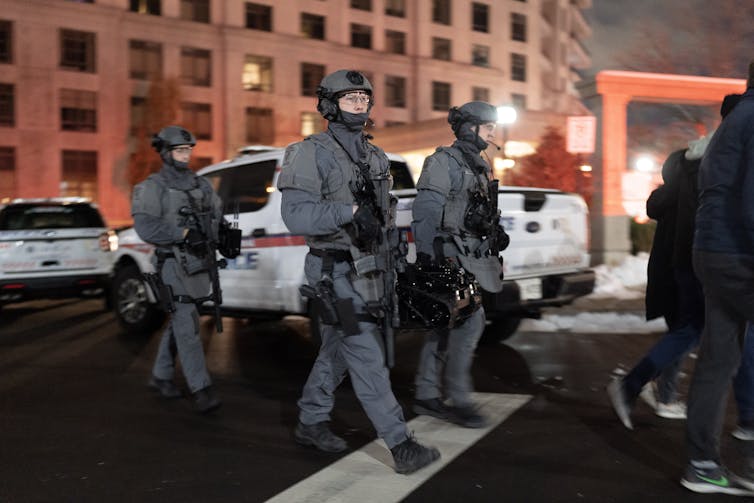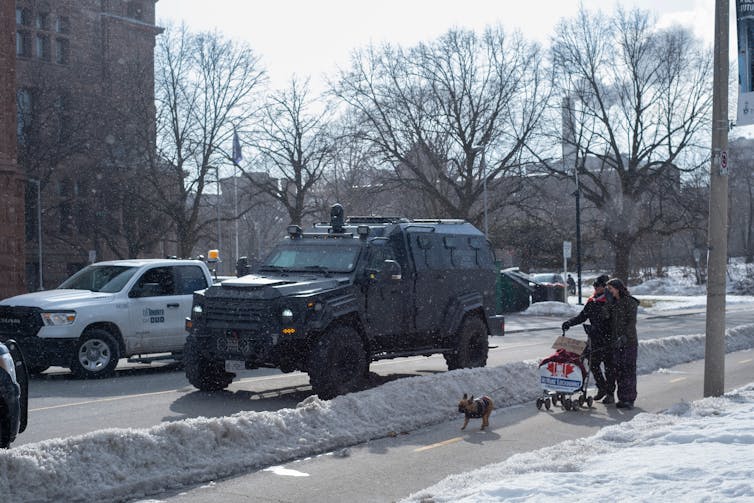
Ejaz Choudry, a 62-year-old Mississauga resident in the midst of a mental health crisis, was shot dead by Peel Regional Police’s Tactical and Rescue Unit in June 2020. Choudry’s death renewed public concern about police use of force and draws attention to the use of police tactical units to respond to incidents involving people in mental distress.
Interactions with tactical units can be among the most violent citizen-police encounters. These units rely on the use of military-like weapons, flashbangs, battering rams and a range of other specialized equipment. But the militarization of these police units is not a new phenomenon or trend. Canadian research has highlighted concerns about the increasing use of tactical units at incidents that are regarded as more common or routine.

In October 2022, the Toronto Police Service released a podcast episode about its tactical unit, the Emergency Task Force (ETF). A scene in the episode depicts two ETF officers brandishing and shooting assault rifles with a suppressor and wearing helmets reminiscent of those worn by military personnel.
Why are police, who are meant to ensure public safety, increasingly mirroring military units designed for warfare?
Mirroring military units
Most people would struggle to distinguish the Toronto Police’s ETF from a military unit. In my research I aim to understand the lived experiences of individuals who encounter police tactical units. After seeing ETF officers equipped similarly to military units, I began investigating how police are becoming more militarized.
My research, currently under peer-review, compared images of Toronto’s ETF to Canadian Armed Forces infantry and American and Canadian special forces units between 2008 and 2023. The research investigated whether police units adopted gear, like helmets, tactical pants and assault rifles, similar to those used by the military. The approach was premised on studying the similarities in equipment and weaponry between military special forces and police tactical units.
The findings show that, from 2016 onward, the Toronto Police’s ETF began to increasingly look more like military special forces units. This is concerning, as these specialized units are tasked with prosecuting wars and killing enemies, whereas the preservation of life is among the central aims of the police.

Tactics used on civilians
Among the most troubling aspects of increased militarization is how police units are using military technology and tactics on civilians. Police tactical units often engage in nighttime or early morning raids, times when it is common to find family members, including children, at home.
There are instances where police raid the wrong home or encounter individuals who are not involved in criminal activity. The trauma from these encounters cannot be understated. Many of the citizens I have interviewed in my research indicate experiencing nightmares, insomnia, having flashbacks and being in a state of constant hypervigilance.
By adopting military technology and tactics, police are treating our cities and communities like theatres of war, and treating civilians as the enemy. The implied message of such militarized equipment is that the civilian population is a threat and war-like tactics are needed to respond to that threat.
Like other policing practices, the use of tactical units disproportionately affects racialized people, those living with mental illnesses and those in economically marginalized communities. The police-involved deaths of Choudry, Anthony Aust and Taresh Ramroop are reminders of the fatal consequences of militarized policing in Canada.
Tactical officers have also been deployed in response to Indigenous land rights movements. This demonstrates how police rely on heavily militarized responses in numerous contexts, not just criminal activity.
Read more: Indigenous civil rights blockades should be met with a new diplomacy, not violence
These practices contribute to the dehumanization and criminalization of racialized people and those living in poverty. They encourage an “us vs. them” mentality and ultimately undermine the potential for community-based models of policing.
Equipping police like military units, who are tasked with fighting wars and killing enemies, undermines the fundamental goal of policing: protecting people. It undermines public trust in the police and damages the very communities the police aim to serve.
Tandeep Sidhu receives funding from the Social Sciences and Humanities Research Council of Canada (SSHRC).
This article was originally published on The Conversation. Read the original article.







